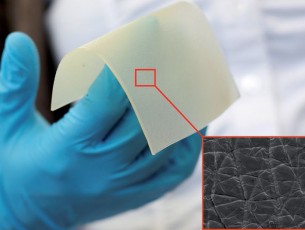“Touché” – a European research consortium is examining how we perceive textile materials on our skin.
BOENNIGHEIM – Earlier this year, the European research project “Touché” was set up, with the title “Boosting innovation through application of a basic understanding of the process and testing of textile touch and fabric feel”. The joint German-Belgian project, part of the CORNET (Collective Research Networking) undertaking by the “Otto von Guericke” e.V. Federation of Industrial Research Associations (AiF, No. 137 EN), is addressing as yet unresolved issues relating to the interaction between human skin and textiles, and how textiles are perceived.
The German research team at the Hohenstein Institute is focusing specifically on the interactions and perception of textiles on the surface of the human body, that is to say, while wearing clothing or lying on them. This is described as the “fabric feel”. At the same time, the project partners from the University and University College Ghent are investigating whether the way that textiles feel when you actively touch them (the so-called “hand of touch” or “textile touch”) can be scientifically measured. By taking this broadly based approach, the researchers will be able to study the ways in which the haptic stimuli that we experience when taking hold of a textile differ from the tactile stimuli experienced during the passive wearing of clothing. In the process, they want to identify those textile parameters which affect human perception. This is important in order to be able to make technical predictions along the textile production chain, and so understand how the textiles will be experienced by the user.
For the purposes of their research into the interactions between textiles and humans, the scientists at Hohenstein have developed their own synthetic skin called “HUMskin” in their Life Sciences department. This has many of the same physiological properties as human skin and the same surface profile as the outermost layer of our skin. With the help of HUMskin, wearing experiences on the human body can be realistically simulated in the laboratory and the effects of different kinds of friction (e.g. static and dynamic friction) on the skin can be accurately measured. In the Touché project, this so-called tribological data, in combination with 3D data at microscopic level, is delivering a detailed understanding of materials and the values that can be expected for friction processes, and how textiles are perceived on the skin.
At the same time, also as part of the project, the Hohenstein Institute’s electromechanical textile applicator SOFIA has been further refined (SOFIA = Standardized Operating FabrIc Applicator). SOFIA 2 is now able to apply textile samples to different parts of volunteers’ bodies at different speeds and pressures, and SOFIA 2 can also simultaneously measure the friction coefficients during the application. SOFIA enables textile samples to be applied to volunteers in an entirely standardized way. In order to evaluate the volunteers’ perceptions of the textiles objectively, the electrical activity that occurs spontaneously and subconsciously in their brains while the textile samples are being applied is measured using electroencephalography (EEG). Preliminary neurophysiological tests using 64-channel EEG have already shown that the human brain is capable of detecting textiles which have pleasant or unpleasant surface properties.
 SleepTech Magazine Mattress, Accessories, Machinery, Raw Materials
SleepTech Magazine Mattress, Accessories, Machinery, Raw Materials



